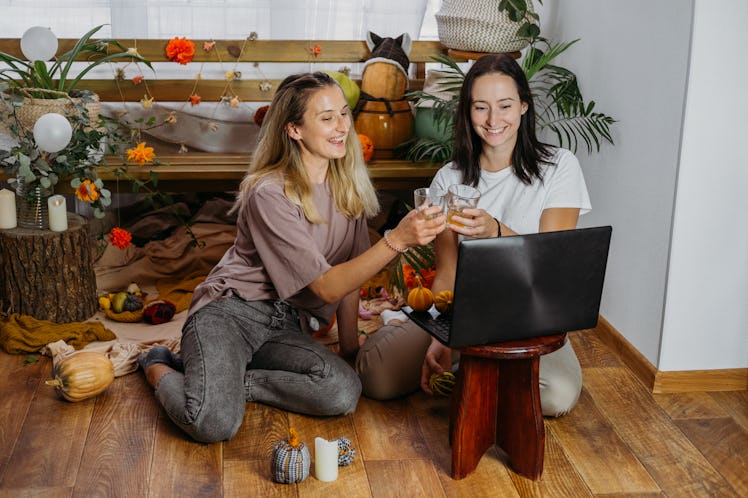
Experts Explain Why You May Need To Go Virtual For Friendsgiving This Year
You’re probably gearing up for a very different Thanksgiving than years past during the ongoing coronavirus pandemic. Some traditions, like baking the perfect pumpkin pie, aren’t in jeopardy, but with the U.S. Centers for Disease Control and Prevention (CDC) cautioning against large indoor gatherings, you might be wondering if it’s safe to host Friendsgiving in 2020. If you’re already planning a guest list, curating a menu, and crafting individualized place settings, you may be getting ahead of yourself.
As much as you want to get together with friends for the holidays, it’s crucial to consider the risks. According to the CDC as of Nov. 11, a virtual celebration or a small dinner with only people who live in your household are the lowest risk options. The risk increases as you include more people outside of your immediate living space — the CDC lists small or medium-sized outdoor gatherings with family and friends in your community as a moderate risk. Any indoor activities, like a Friendsgiving dinner, with people outside of your household pose the highest risk. In fact, the CDC names "small household gatherings" as "an important contributor to the rise in COVID-19 cases." You can keep up with the latest coronavirus holiday guidance on the CDC's holiday celebration webpage.
Dr. John Swartzberg, M.D., F.A.C.P., clinical professor emeritus of infectious diseases and vaccinology at Berkeley Public Health, tells Elite Daily a virtual celebration is the safest option. Putting it plainly, Dr. Swartzberg says, “This virus does not respect our holidays.”
Dr. Swartzberg notes inadequate social distancing and frequently taking off masks for drinking and eating can contribute to the spread of COVID-19 during a time when cases are already spiking around the country. "Groups of people coming together inside is a recipe for disaster," he explains.
With colder weather rolling in, there are fewer options for lower risk outdoor gatherings. Dr. Michelle Barron, M.D., Senior medical director for infection prevention and control at UCHealth, tells Elite Daily if you aren't part of an individual's bubble, attending Friendsgiving can put you at high risk for contracting or transmitting COVID-19.
"A lot of these [holiday] occasions occur indoors. In the summer, you [had] more space because [you were] outside and you had air circulation in your favor,” Dr. Barron explains. “As the weather gets colder ... it makes it a little bit more challenging to do that."
Experts warn there is no way to make an indoor gathering during the pandemic completely safe. “Risk can only be mitigated,” says Dr. Swartzberg. Some steps you can take to mitigate the risk include holding any gatherings outside, limiting the guest list to people in your bubble, wearing face masks, and having people quarantine 14 days before Friendsgiving.
Dr. Swartzberg adds that even if people quarantine for 14 days prior to a Friendsgiving, there's still a risk when traveling. "If people need to travel by plane, train, or bus ... they could get infected during their travel," he notes.
If you’re not going virtual, Dr. Swartzberg recommends opting for an outdoor gathering, using heat lamps to keep people warm. He also suggests wearing a mask outside, especially if you can’t maintain distance from others and if there are several people from outside of your bubble there.
If you must host an indoor event, it's important to increase ventilation as much as possible and keep the guest list small. Open windows and doors and avoid fully enclosed spaces. Dr. Swartzberg says taking off your mask indoors is "too risky," which can obviously present a problem if you need to eat and drink.
He suggests serving one person at a time rather than a buffet or potluck. People should also bring their own plates, utensils, glasses, and serving equipment. When eating, guests should be as far away as possible from others outside their own bubble (a minimum of 6 feet). You should also keep the get-together shorter than normal, since according to CDC guidance as of Nov. 11, longer gatherings are a greater risk, and "being within 6 feet of someone who has COVID-19 for a cumulative total of 15 minutes or more greatly increases the risk of becoming sick."
The CDC also emphasizes following all local laws and regulations regarding indoor gatherings and quarantining when traveling out of state. As of Nov. 11, the CDC is urging people to forego travel plans and in-person gatherings in order to help stem the spread of COVID-19. Anyone who is currently sick or has been exposed to coronavirus, as well as anyone with an increased risk of severe illness, should avoid attending any in-person gatherings.
If you think you’re showing symptoms of coronavirus, which include fever, shortness of breath, and cough, call your doctor before going to get tested. If you’re anxious about the virus’s spread in your community, visit the CDC for up-to-date information and resources, or seek out mental health support. You can find all Elite Daily's coverage of coronavirus here.
Experts cited:
Dr. John Swartzberg, M.D., F.A.C.P., clinical professor emeritus at the UC Berkeley School of Public Health's Division of Infectious Diseases and Vaccinology
Dr. Michelle Barron, M.D., Senior medical director for infection prevention and control at UCHealth